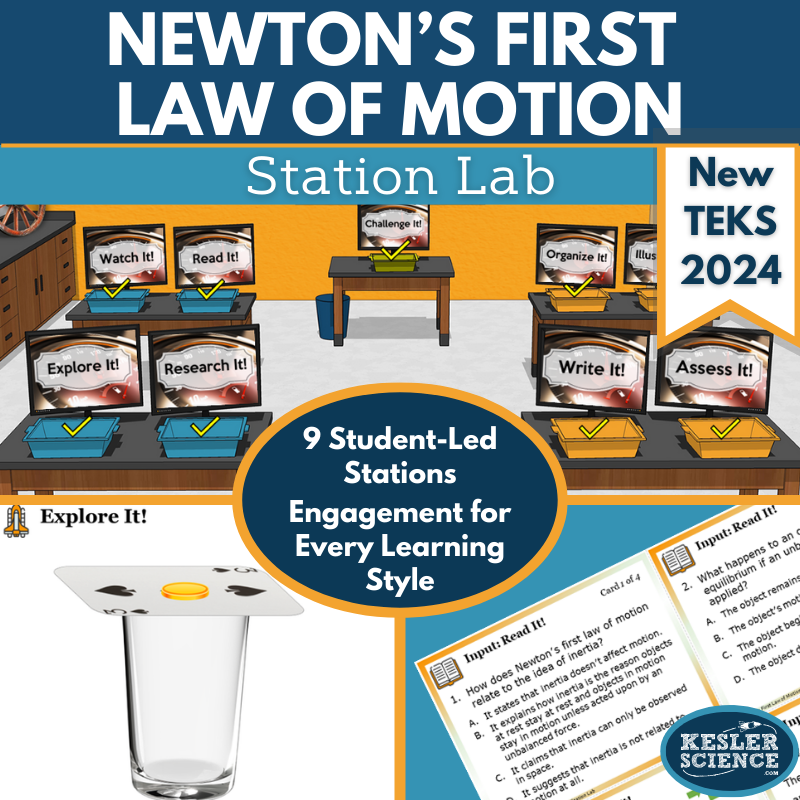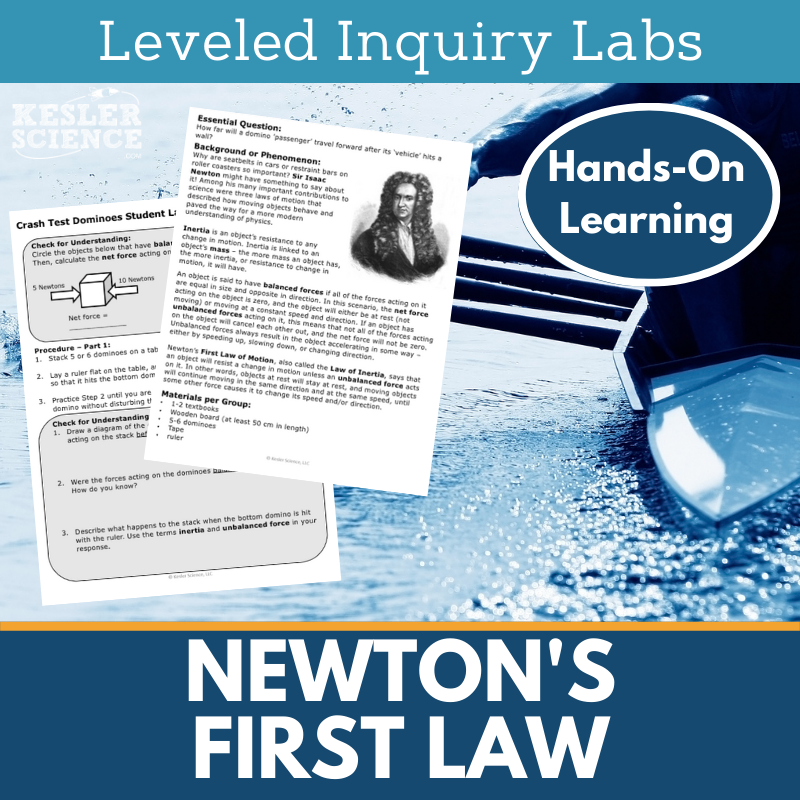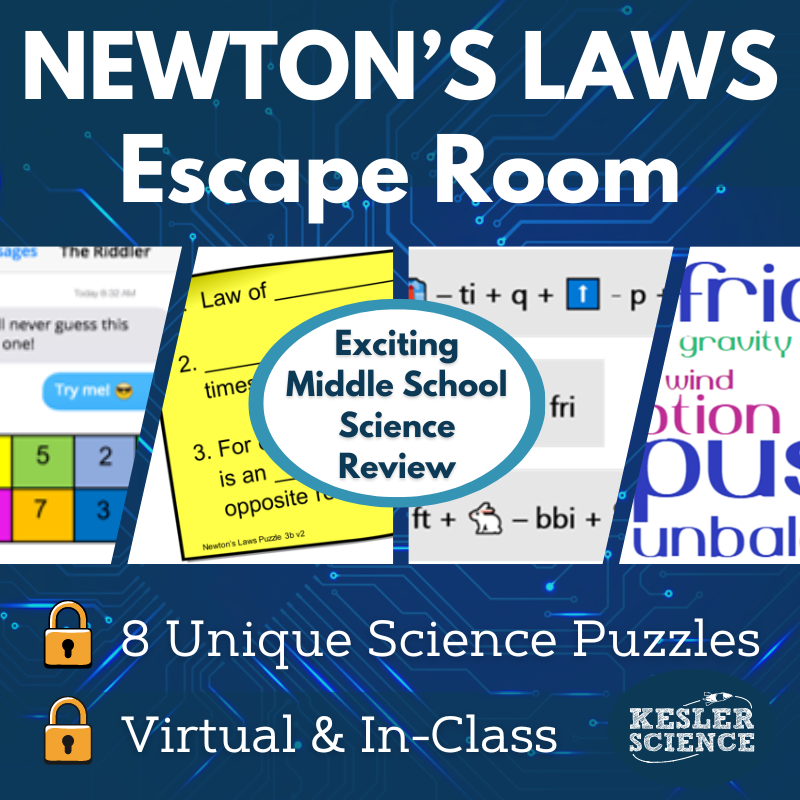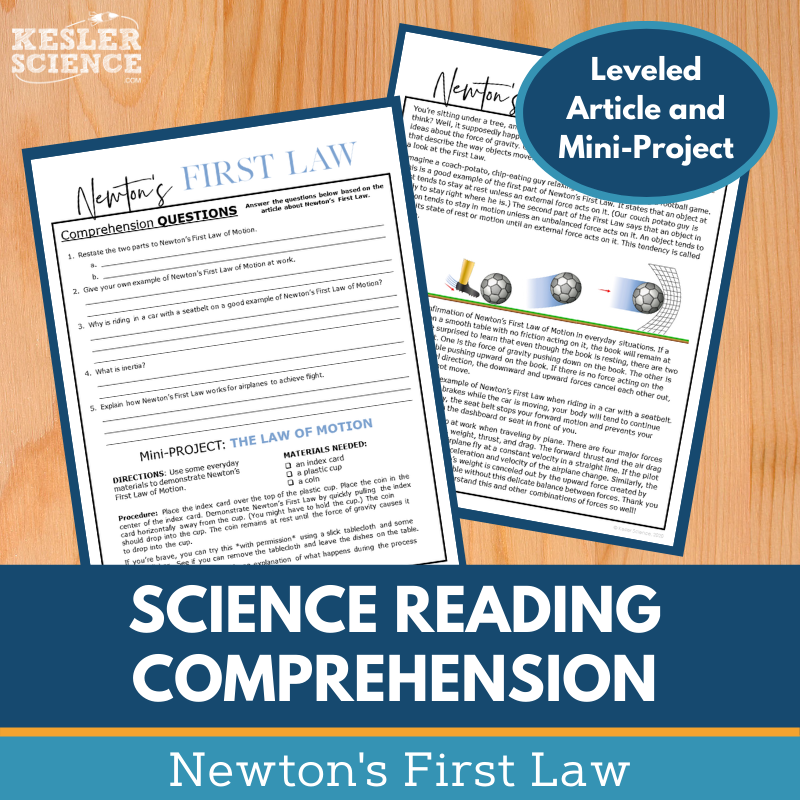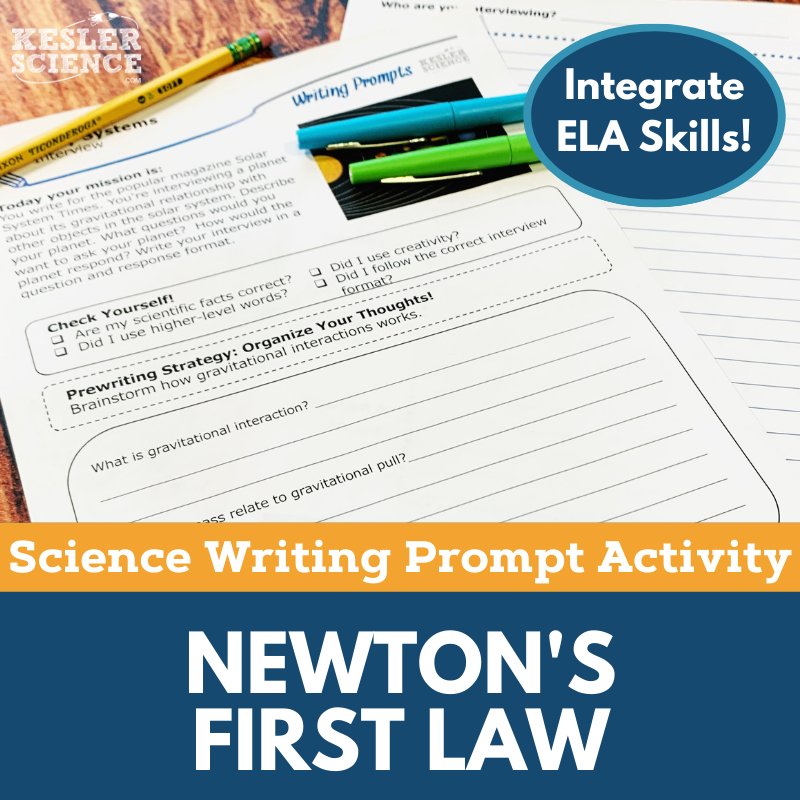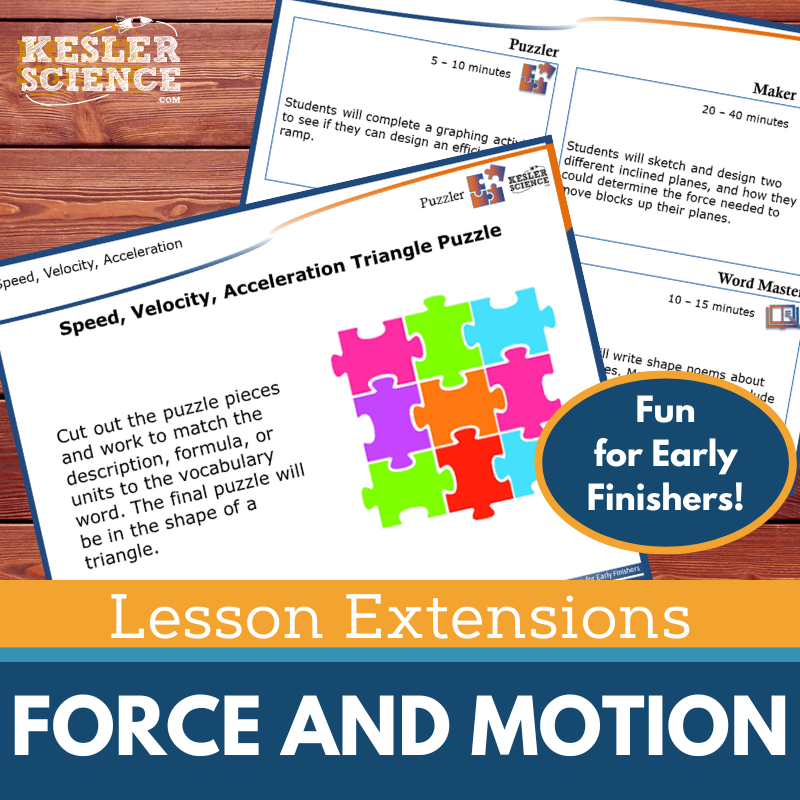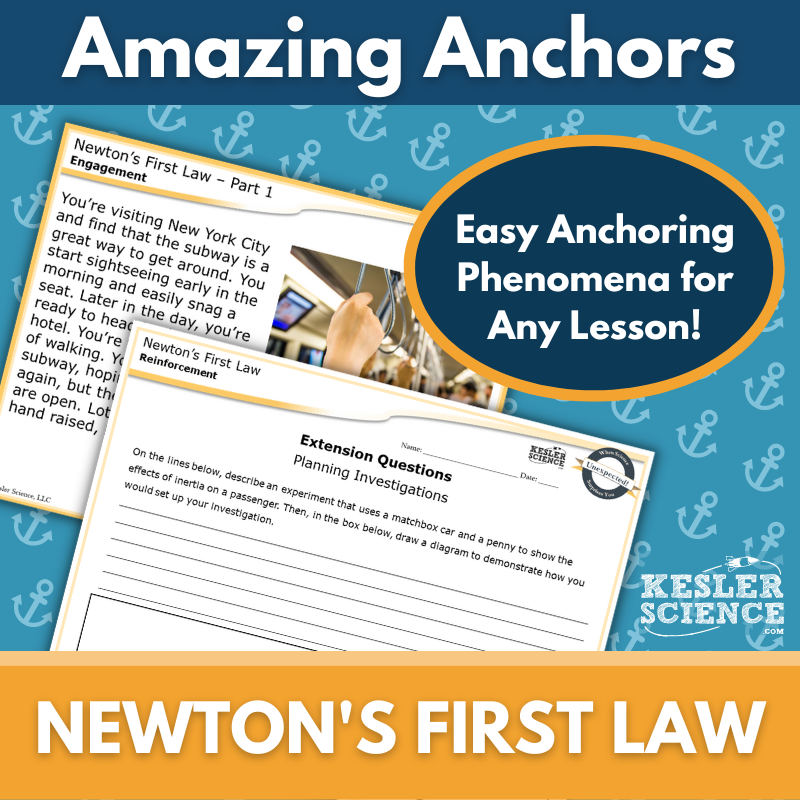Newton's First Law of Motion Activities for Middle School Science
Explore Newton’s first law of motion with this engaging 5E lesson that examines the effects of balanced and unbalanced forces on motion. The resources below will give students a comprehensive understanding of Newton's first law of motion. All of the following materials are also included in the Kesler Science Membership.
The Kesler Science Newton's First Law of Motion 5E Lesson is a comprehensive, student-led unit exploring Newton’s first law and the effects of balanced and unbalanced forces on motion. This editable, low-prep lesson includes presentations, worksheets, assessments, and student-choice projects designed for differentiated learning. It aligns with the 2021 TEKS 7.7D standard and offers materials in both English and Spanish.
Students engage with essential questions through a structured 5E Model. The exploration phase features a hands-on, differentiated station lab with nine stations incorporating multimodal learning—hands-on experiments, reading passages, research tasks, videos, categorization activities, writing prompts, illustrations, assessments, and an extension station. Editable PowerPoints, interactive notebooks, and note-taking templates support student understanding in the explanation phase. The elaboration phase includes choice projects applying Newton’s first law, while evaluation resources provide STAAR 2.0-aligned assessments and review materials.
Designed for maximum flexibility, this lesson can be implemented in print or digital formats for in-class or virtual learning. With differentiated support and engaging activities, it ensures all students grasp key physics concepts while giving teachers more time to focus on student success.
The Kesler Science Newton's First Law of Motion 5E Lesson is a comprehensive, student-led unit exploring Newton’s first law and the effects of balanced and unbalanced forces on motion. This editable, low-prep lesson includes presentations, worksheets, assessments, and student-choice projects designed for differentiated learning. It aligns with the 2021 TEKS 7.7D standard and offers materials in both English and Spanish.
Students engage with essential questions through a structured 5E Model. The exploration phase features a hands-on, differentiated station lab with nine stations incorporating multimodal learning—hands-on experiments, reading passages, research tasks, videos, categorization activities, writing prompts, illustrations, assessments, and an extension station. Editable PowerPoints, interactive notebooks, and note-taking templates support student understanding in the explanation phase. The elaboration phase includes choice projects applying Newton’s first law, while evaluation resources provide STAAR 2.0-aligned assessments and review materials.
Designed for maximum flexibility, this lesson can be implemented in print or digital formats for in-class or virtual learning. With differentiated support and engaging activities, it ensures all students grasp key physics concepts while giving teachers more time to focus on student success.
Engage your middle school students with this student-led station lab aligned with TEKS 7.7D, exploring Newton’s first law of motion. Designed for in-class or virtual learning, this interactive lesson allows students to analyze the effects of balanced and unbalanced forces on an object’s motion through nine engaging stations.
Students encounter new concepts through activities like hands-on exploration, video analysis, reading comprehension, and research. They demonstrate their learning by organizing information, illustrating models, writing responses, and completing assessments. A bonus challenge station provides extension activities and differentiated reading passages in English and Spanish support varied learning needs.
This low-prep, high-engagement resource promotes active learning and critical thinking.
Engage your middle school students with this student-led station lab aligned with TEKS 7.7D, exploring Newton’s first law of motion. Designed for in-class or virtual learning, this interactive lesson allows students to analyze the effects of balanced and unbalanced forces on an object’s motion through nine engaging stations.
Students encounter new concepts through activities like hands-on exploration, video analysis, reading comprehension, and research. They demonstrate their learning by organizing information, illustrating models, writing responses, and completing assessments. A bonus challenge station provides extension activities and differentiated reading passages in English and Spanish support varied learning needs.
This low-prep, high-engagement resource promotes active learning and critical thinking.
The Newton’s First Law of Motion Student Choice Projects align with the 2021 TEKS standard 7.7D, offering middle school students a variety of creative ways to demonstrate their understanding. A project page outlines six student-led options plus a “design your own” project, with an editable rubric for teacher, peer, or self-assessment.
These flexible projects provide multimodal opportunities for students to showcase their learning. Two versions of the project page support differentiation, with modified options for students needing remediation and challenge options for advanced learners. Teachers can adjust the rubric to fit grading needs.
The projects use standard classroom supplies like paper, markers, and scissors, with many options available for digital completion.
The Newton’s First Law of Motion Student Choice Projects align with the 2021 TEKS standard 7.7D, offering middle school students a variety of creative ways to demonstrate their understanding. A project page outlines six student-led options plus a “design your own” project, with an editable rubric for teacher, peer, or self-assessment.
These flexible projects provide multimodal opportunities for students to showcase their learning. Two versions of the project page support differentiation, with modified options for students needing remediation and challenge options for advanced learners. Teachers can adjust the rubric to fit grading needs.
The projects use standard classroom supplies like paper, markers, and scissors, with many options available for digital completion.
The Unbalanced Forces Inquiry Lab aligns with TEKS, helping students demonstrate and calculate how unbalanced forces change the direction of an object's motion through an interactive board game. This resource includes three differentiated labs designed to support various learning levels.
The Dependent Lab provides a guided experience with procedural instructions and inquiry questions for on-level learners. The Modified Lab offers a more structured approach with sentence stems and multiple-choice questions for students needing additional support. The Independent Lab encourages advanced learners to take ownership of the experiment with minimal guidance.
Included resources feature editable teacher pages with prep instructions, objectives, and materials lists, along with answer keys and CER-based reflection questions. Required materials include Newton cards, a football field board, push force arrows, a die, and dry-erase markers for independent learners, making this lab an engaging, hands-on exploration of force and motion.
The Unbalanced Forces Inquiry Lab aligns with TEKS, helping students demonstrate and calculate how unbalanced forces change the direction of an object's motion through an interactive board game. This resource includes three differentiated labs designed to support various learning levels.
The Dependent Lab provides a guided experience with procedural instructions and inquiry questions for on-level learners. The Modified Lab offers a more structured approach with sentence stems and multiple-choice questions for students needing additional support. The Independent Lab encourages advanced learners to take ownership of the experiment with minimal guidance.
Included resources feature editable teacher pages with prep instructions, objectives, and materials lists, along with answer keys and CER-based reflection questions. Required materials include Newton cards, a football field board, push force arrows, a die, and dry-erase markers for independent learners, making this lab an engaging, hands-on exploration of force and motion.
The Newton's Laws Escape Room is an interactive activity where students apply their understanding of Newton’s three laws in an engaging, hands-on way. Designed for TEKS and NGSS, this escape room challenges students to identify and apply Newton’s laws to real-world scenarios while reinforcing key vocabulary like inertia, force, mass, acceleration, and friction.
Teachers have full control over the eight independent puzzles, allowing customization based on class time and student needs. The activity can be conducted using manila envelopes or an authentic lock-and-box setup, with all necessary instructions provided. A digital version is available for online learning via PowerPoint or Google Slides, and a printable version can be used at home.
This resource includes teacher directions, a detailed answer key, editable templates, a digital answer sheet, and a video challenge to enhance the experience. Students will stay engaged with eight unique puzzles, printable props, reward templates, and fun photo signs. This immersive escape room will have students talking about Newton’s laws long after the challenge ends!
The Newton's Laws Escape Room is an interactive activity where students apply their understanding of Newton’s three laws in an engaging, hands-on way. Designed for TEKS and NGSS, this escape room challenges students to identify and apply Newton’s laws to real-world scenarios while reinforcing key vocabulary like inertia, force, mass, acceleration, and friction.
Teachers have full control over the eight independent puzzles, allowing customization based on class time and student needs. The activity can be conducted using manila envelopes or an authentic lock-and-box setup, with all necessary instructions provided. A digital version is available for online learning via PowerPoint or Google Slides, and a printable version can be used at home.
This resource includes teacher directions, a detailed answer key, editable templates, a digital answer sheet, and a video challenge to enhance the experience. Students will stay engaged with eight unique puzzles, printable props, reward templates, and fun photo signs. This immersive escape room will have students talking about Newton’s laws long after the challenge ends!
This Newton’s First Law of Motion Science Reading Comprehension Lesson engages students with a nonfiction article, comprehension questions, and a hands-on mini-project using everyday materials. Designed for grades 6-8 (and advanced 5th graders), the leveled passage enhances science literacy and reading comprehension.
The resource includes two leveled articles (Lexile 1100-1300), five to seven comprehension questions, a Cornell notes template, and an interactive mini-project. It features engaging graphics that print well in grayscale.
Suitable for virtual and in-person learning, the resource is compatible with Google Classroom, MS Teams, Schoology, and Canvas. Students can complete activities digitally or on paper. Ideal for sub plans, extra credit, ISS, or whole-class instruction, this resource fosters critical thinking, classroom discussions, and textual analysis while reinforcing Newton’s first law concepts.
This Newton’s First Law of Motion Science Reading Comprehension Lesson engages students with a nonfiction article, comprehension questions, and a hands-on mini-project using everyday materials. Designed for grades 6-8 (and advanced 5th graders), the leveled passage enhances science literacy and reading comprehension.
The resource includes two leveled articles (Lexile 1100-1300), five to seven comprehension questions, a Cornell notes template, and an interactive mini-project. It features engaging graphics that print well in grayscale.
Suitable for virtual and in-person learning, the resource is compatible with Google Classroom, MS Teams, Schoology, and Canvas. Students can complete activities digitally or on paper. Ideal for sub plans, extra credit, ISS, or whole-class instruction, this resource fosters critical thinking, classroom discussions, and textual analysis while reinforcing Newton’s first law concepts.
The Newton’s First Law Science Writing Prompt Activity engages middle school students in an interactive writing exercise using a commercial format to reinforce their understanding of physical science. Aligned with TEKS, this activity explores Newton’s first law through real-world applications such as vehicle restraints, sports, and amusement park rides. Designed for both in-person and virtual learning, it enhances science reasoning while encouraging creativity.
This resource includes teacher directions with answer guides and rubrics, full-sized and half-sheet handouts for flexibility, a projection version for classroom display, and a digital interactive version compatible with PowerPoint and Google Slides. It serves as a cross-curricular activity, pre-test assessment, student choice project, or differentiation exercise. Ideal for early finishers, extra credit, make-up work, or TELPAS samples, this engaging writing prompt fosters deeper science comprehension and can be displayed on a bulletin board or compiled into a student anthology.
The Newton’s First Law Science Writing Prompt Activity engages middle school students in an interactive writing exercise using a commercial format to reinforce their understanding of physical science. Aligned with TEKS, this activity explores Newton’s first law through real-world applications such as vehicle restraints, sports, and amusement park rides. Designed for both in-person and virtual learning, it enhances science reasoning while encouraging creativity.
This resource includes teacher directions with answer guides and rubrics, full-sized and half-sheet handouts for flexibility, a projection version for classroom display, and a digital interactive version compatible with PowerPoint and Google Slides. It serves as a cross-curricular activity, pre-test assessment, student choice project, or differentiation exercise. Ideal for early finishers, extra credit, make-up work, or TELPAS samples, this engaging writing prompt fosters deeper science comprehension and can be displayed on a bulletin board or compiled into a student anthology.
The WIKI Tickets© Force and Motion Set provides engaging, flexible formative assessments for 6th-8th grade science. This set includes 14 assessments, each available in five formats: a full-screen projection version, three printable handouts (full, split, and quarter-page sizes), and a digital interactive version compatible with PowerPoint and Google Slides.
Aligned with NGSS and TEKS standards, these assessments cover key topics such as calculating speed, unbalanced forces, graphing motion, gravity and mass, inclined planes, invisible forces, Newton’s laws, speed and acceleration, and velocity. Each standard has at least one corresponding ticket, with some topics featuring multiple assessments. A bonus table of contents file is included for alignment reference.
These versatile assessments can be used in both in-person and virtual learning settings. Students can respond on paper, interact with the digital version, or work in a 1:1 classroom environment. Whether used as exit tickets, bellringers, or quick checks, WIKI Tickets© offer an effective way to gauge student understanding in an engaging format.
The WIKI Tickets© Force and Motion Set provides engaging, flexible formative assessments for 6th-8th grade science. This set includes 14 assessments, each available in five formats: a full-screen projection version, three printable handouts (full, split, and quarter-page sizes), and a digital interactive version compatible with PowerPoint and Google Slides.
Aligned with NGSS and TEKS standards, these assessments cover key topics such as calculating speed, unbalanced forces, graphing motion, gravity and mass, inclined planes, invisible forces, Newton’s laws, speed and acceleration, and velocity. Each standard has at least one corresponding ticket, with some topics featuring multiple assessments. A bonus table of contents file is included for alignment reference.
These versatile assessments can be used in both in-person and virtual learning settings. Students can respond on paper, interact with the digital version, or work in a 1:1 classroom environment. Whether used as exit tickets, bellringers, or quick checks, WIKI Tickets© offer an effective way to gauge student understanding in an engaging format.
Lesson Extensions provide engaging, student-choice activities designed to challenge early finishers and deepen their understanding of force and motion standards. These activities help reinforce critical thinking, creativity, and problem-solving while keeping students actively engaged during lesson wrap-ups or downtime.
Each extension includes four interactive components: Puzzler for problem-solving, Maker Space for hands-on STEAM activities, Tech Connection for digital demonstrations, and Word Master for creative writing. With teacher directions, answer keys, and both print and projection versions, these extensions offer high-level, rigorous enrichment opportunities that align with NGSS and TEKS standards.
Covering topics such as Newton’s laws, speed and acceleration, electromagnetic forces, gravity, and unbalanced forces, these resources help students explore key physics concepts in an engaging and meaningful way.
Lesson Extensions provide engaging, student-choice activities designed to challenge early finishers and deepen their understanding of force and motion standards. These activities help reinforce critical thinking, creativity, and problem-solving while keeping students actively engaged during lesson wrap-ups or downtime.
Each extension includes four interactive components: Puzzler for problem-solving, Maker Space for hands-on STEAM activities, Tech Connection for digital demonstrations, and Word Master for creative writing. With teacher directions, answer keys, and both print and projection versions, these extensions offer high-level, rigorous enrichment opportunities that align with NGSS and TEKS standards.
Covering topics such as Newton’s laws, speed and acceleration, electromagnetic forces, gravity, and unbalanced forces, these resources help students explore key physics concepts in an engaging and meaningful way.
This Amazing Anchors Phenomenon Lesson engages students with Newton’s first law through a real-world connection to a New York City subway ride. The introductory reading includes comprehension and extension questions to prepare students for further learning, while the explanatory reading breaks down the science behind Newton’s first law in an accessible way, reinforced with additional questions.
Aligned with TEKS, this no-prep resource includes teacher directions with answer keys, projection slides, and both print and digital formats for Google Classroom and other LMS platforms. A modified version supports student comprehension with differentiated language and sentence starters. Designed to bookend a lesson, these engaging readings serve as effective supplements in any classroom setting.
This Amazing Anchors Phenomenon Lesson engages students with Newton’s first law through a real-world connection to a New York City subway ride. The introductory reading includes comprehension and extension questions to prepare students for further learning, while the explanatory reading breaks down the science behind Newton’s first law in an accessible way, reinforced with additional questions.
Aligned with TEKS, this no-prep resource includes teacher directions with answer keys, projection slides, and both print and digital formats for Google Classroom and other LMS platforms. A modified version supports student comprehension with differentiated language and sentence starters. Designed to bookend a lesson, these engaging readings serve as effective supplements in any classroom setting.
Year-Round Resources
These year-round activities will increase your students' understanding of many middle school science topics. All of these activities are also included in the Kesler Science Membership.
Visual Data & Graphing
You're not alone if your students struggle with understanding graphs, charts, and tables. It's a skill that takes an enormous amount of practice. This resource will help students build a strong foundation in analyzing data and creating their own data visualizations.
Bell Ringers and Warm-Ups
These middle school science bell ringers are an excellent way to engage your students as soon as they walk into your classroom. This comprehensive FULL YEAR resource includes everything you need to start off each science class with an interesting warm-up activity.
Review Board Games
Each game board has been carefully designed to keep students engaged. There are 10 different action spaces on each board and dozens of question cards. All of the actions are related to science concepts and keep the students motivated throughout the game.
Each game is ready to play. Simply print out the board and the cards and let the students enjoy reviewing nine different units.
Essential Questions and Standards
Below are the essential questions and standards associated with the lessons and activities included in the atoms unit. This topic is only one of more than 100 middle school science topics included in the Kesler Science Membership.
-
What is Newton’s first law of motion?
-
How do balanced and unbalanced forces affect the state of motion of objects using Newton’s first law of motion?
-
TEKS Science - 7.7D Newton's First Law of Motion
Kesler Science Membership
Imagine never having to search for another middle school science lesson again. The membership gives you access to ALL of the Kesler Science products in one place (Yes, including everything above).
Say goodbye to long hours of lesson prep.



